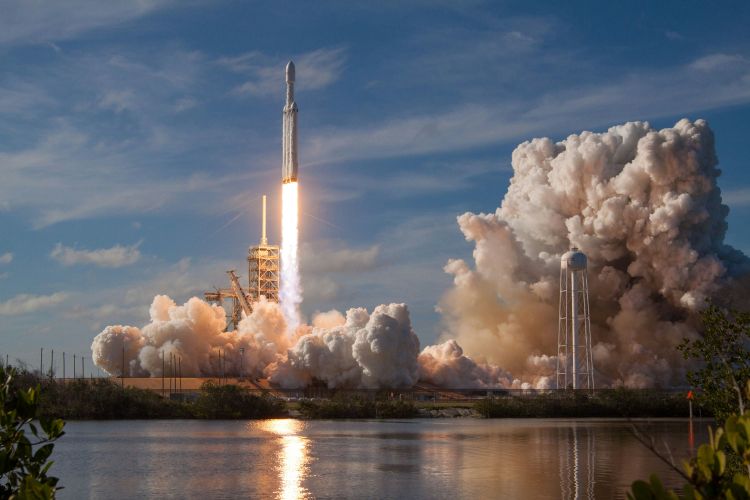
India aspires to a leading player in the global space economy which is valued at $450 billion in 2023. The global industry is projected to grow to around$1.05 trillion by 2035 (Figure 1). To capitalise on this opportunity, India must intensify its efforts with a missionary zeal to explore commercial prospects across all possible sectors, segments, and regions.
Historically, India’s space sector has been dominated by the Indian Space Research Organisation (ISRO), a beacon of technological excellence. Recent regulatory reforms have reorganised ISRO into three distinct entities with well-defined roles, strategically positioning India to tap into the global space economy. ISRO’s track record of cost-effective and successful missions has already established India as a formidable player in space industry.
READ | Trade deficit with China casts shadow over Indian economy
The liberalisation of India’s space policies, including the creation of the Indian National Space Promotion and Authorisation Centre (IN-SPACe), marks a significant shift towards increased private sector participation. By streamlining regulations, offering incentives, and fostering innovation, India can unlock significant growth in its space economy.
Tapping global opportunities
To fully capitalise on the potential of the global space economy, India must strategically target high-growth sectors and regions. Key segments that can be commercially exploited by Indian private sector companies include satellite manufacturing and launch services, earth observation and remote sensing, space-based internet services, space tourism, defence and security, telecommunications, climate and environmental monitoring, navigation and positioning, agriculture and food security, space exploration and research, and space debris management.
By 2025, the market value of India’s space segments is projected to see significant growth. Satellite services are expected to reach $4.6 billion, driven by increasing demand for communication and broadcasting services. The ground segment, which includes infrastructure like ground stations and user terminals, is projected to reach $4 billion. Satellite manufacturing is anticipated to grow to $3.2 billion, driven by the demand for new satellites across various sectors. Launch services are expected to be valued at $1.05 billion, highlighting India’s continued role as a key provider of efficient launch solutions to the global market.
The small and nano-satellite segment presents significant opportunities, driven by the rising global demand for communication, Earth observation, and navigation services. India’s economical launch services, particularly through ISRO’s Polar Satellite Launch Vehicle (PSLV), have already attracted international clients. For example, PSLV has successfully launched numerous foreign satellites, demonstrating India’s capability to offer reliable and affordable solutions.
In the telecommunications sector, India can expand its satellite communication services to meet global demand, particularly in remote and underserved areas. Additionally, climate and environmental monitoring, navigation and positioning services, and agriculture-focused satellite applications represent areas where India can leverage its existing capabilities to drive growth. The rapid development of India’s NAVIC system, which enables the required software and hardware in phones and computers to scale its usage domestically, will significantly reduce India’s reliance on imported information and navigation services.
The growing demand for earth observation and remote sensing services, essential for sectors like agriculture, disaster management, and climate monitoring, positions India as a key player in the global market. Companies like Pixxel, an Indian startup, are already making strides in this area by developing advanced imaging satellites for global clients.
Similarly, space-based internet services are another promising area, particularly in regions like Africa and Southeast Asia, where connectivity challenges persist. By developing satellite constellations or partnering with global players like SpaceX or OneWeb, India can help address the connectivity needs of underserved regions. This would not only expand India’s influence but also contribute to bridging the digital divide in these areas.
Space tourism, though still nascent, offers potential for India to tap into the growing global market. Additionally, India’s defence and security sector can benefit from satellite-based intelligence, surveillance, and reconnaissance (ISR) services, bolstering national security while offering commercial opportunities.
Focus on Indian capabilities
India is uniquely positioned to excel in the global space economy by leveraging its strengths in affordability and reliability. With Russia’s reduced role due to economic sanctions, India has a prime opportunity to anchor its capabilities and seize global opportunities. The nation’s private sector is rapidly advancing, with startups like Skyroot Aerospace and Agnikul Cosmos leading innovations such as 3D-printed rocket engines and customisable launch vehicles. India should leverage its advanced and affordable rocket technology to target low earth orbit opportunities with its proven expertise in small rocket technology.
Given the space vacated by Russia in the global space economy due to economic sanctions, India is not only uniquely positioned but also capable of anchoring its strengths to tap into global opportunities. Public-private partnerships (PPPs) can be instrumental in accelerating technological advancements and boosting competitiveness, with private entities complementing the expertise and infrastructure of ISRO.
To maintain and grow its influence, India must invest in human capital by strengthening education and training programmes to nurture a skilled workforce capable of driving future space technology advancements. Additionally, India should seek international cooperation, particularly with regions like Africa, Southeast Asia, the Middle East, and Latin America. These areas present untapped markets and opportunities for collaboration in satellite services, space-based internet, and remote sensing.
By prioritising sustainability and adopting best practices in space operations, India can ensure the long-term viability of its space activities. This commitment to environmental stewardship will reinforce India’s role as a responsible leader in the global space economy, fostering economic growth and technological innovation. India is well-positioned to capitalise on its strengths and expand its global influence in the space industry.
Dr Ram Singh is Professor and Head, IIFT, New Delhi. Aaqib Chaudhary is a research scholar at IIFT. Views expressed are personal.
